Honda Pilot: Exterior Lights System Description - Components
Headlights
The headlight assembly consists of the headlights (Low/High beam and daytime running lights* 2 ), the front parking lights/daytime running lights/side marker lights* 1 , and the LED control units* 3 .
*1: With LED daytime running light
*2: Without LED daytime running light
*3: With LED headlight
Front Turn Signal Lights
The front turn signal lights* 1 or turn signal/parking lights* 2 are located under the headlight.
*1: With LED daytime running light
*2: Without LED daytime running light
Rear Combination Lights
The taillights consist of the taillights, the brake lights, the rear turn signal lights, and the rear side marker lights on the outside of the vehicle. The back-up lights and the inner taillights are built into the inner taillights.
High Mount Brake Light
The high mount brake light is located top of the rear window, and it is equipped with the LED.
Side Turn Signal Lights
The side turn signal light is built into the power mirror, and it is equipped with the LED.
Exterior Lights System Description - Control/Function
Headlights Function
The headlights are controlled by the MICU, based on combination light switch input signals.

Headlights Auto-OFF Function
When the headlights auto-off function is selected, the exterior lights automatically turn off when the vehicle is in the OFF (LOCK) mode, and the driver's door is opened and closed. The timing for turning off the exterior lights can be customized to suit the client's needs.

LED Headlight Fault Detection Function
The LED control unit sends the 10 Hz (duty 50 %) signal to the MICU when the headlight is on. If the MICU receives the 5 Hz (duty 50 %) signal, the MICU judges an LED assembly is faulty. If the MICU receives other than 5 Hz or 10 Hz signal, the MICU judges the LED control unit is faulty.

Turn Signal/Hazard Light Function
The turn signal/hazard warning lights are controlled by the MICU, using input from the combination light switch or hazard warning switch signal. When the MICU receives a left turn or right turn command from the combination light switch, it blinks the front and rear turn signal lights for the left or right side of the vehicle. When the MICU receives a hazard warning command from the hazard warning switch, it blinks the front and rear turn signal lights for both sides of the vehicle. The system also includes wire break detection. This monitors the current value using the MICU. An abnormal value is registered as a wire break (open) or faulty bulb. When this occurs, the MICU increases the turn signal lighting frequency. If the break detection shows that the current value has returned to the correct value, the MICU returns to the normal frequency.

One-Push Turn Signal Light
With the vehicle ON mode, when there is a brief input from the turn signal switch (from 40 ms to 1 second), the MICU flashes the left or right turn signal three times in succession.
Fog Light Function
The fog light is controlled by the MICU, based on switch input from the combination light switch.
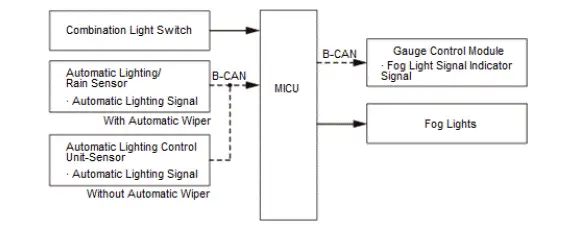
Daytime Running Lights Function
For daytime running light control, the MICU use the combination light switch signal, the parking brake signal, and the auto light signal, and then turns on the light. When the combination light switch is in the AUTO or the PARKING position at the time of the vehicle ON mode, and the parking brake switch is turned off, the MICU transmits an output value to the daytime running lights. When the combination light switch is in the ON position or the AUTO position, and the low beam output signal from the automatic lighting control unit-sensor* 2 or automatic lighting/rain sensor* 1 is input to the MICU, daytime running light control is not performed.
*1: With automatic wiper
*2: Without automatic wiper
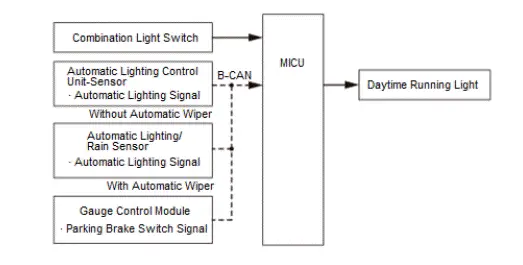
Automatic Lighting ON/OFF Control
The output voltage from the automatic lighting control unit-sensor *2 or automatic lighting/rain sensor *1 varies depending on the brightness around the vehicle. After the delay time elapse, when the output voltage becomes less than light ON threshold, the parking lights, the side marker lights, the taillights, the license plate lights, and the headlights turn on. After the delay time elapse, when the output voltage becomes higher than light OFF threshold, the parking lights, the side marker lights, the taillights, the license plate lights, and the headlights turn off.
*1: With automatic wiper
*2: Without automatic wiper
Without Automatic Wiper
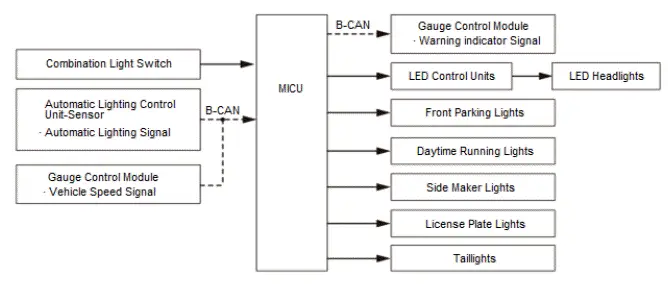
With Automatic Wiper

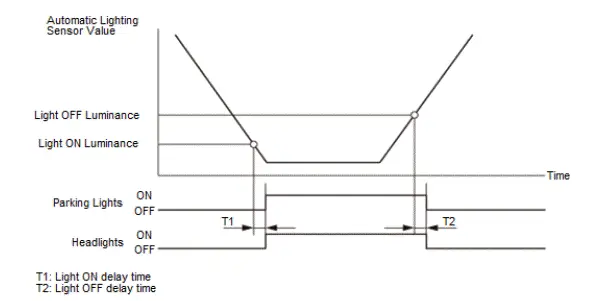
Wiper Linked Mode
When the wiper switch is in a position other than OFF, the MICU counts and records the wiper motor ON to OFF signal (edge count) within 20 seconds from the windshield wiper motor (FR WIPER AS signal). After a total of 4* 1 or 5* 2 counts, it switches to wiper linked mode and turns on the headlights, the parking lights, the taillights, and the side marker lights. The ON/OFF signals at the time of windshield washer operation are not counted. When an edge count is not received for 30 seconds or more, the count is reduced by 1, and shifting to normal mode is done when the count reaches 0. The wipers return to normal when the vehicle is stopped, or when the respective switch is set to OFF.
*1: With automatic wiper
*2: Without automatic wiper
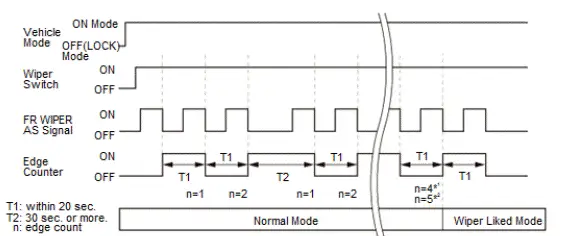
*1: With automatic wiper
*2: Without automatic wiper
Warning Function
Without automatic wiper
The MICU sends an indicator signal to the gauge control module in case of failure that the automatic lighting sensor voltage value is abnormal.
With automatic wiper
The automatic lighting/rain sensor sends an indicator signal to the gauge control module in case of failure of the automatic lighting/rain sensor or when the signal sent from the MICU by B-CAN signal is abnormal.
Interior Lights Brightness Change Control
Regardless of the combination light switch AUTO position, the MICU* 2 or the automatic lighting/rain sensor* 1 controls brightness for daytime or nighttime brightness. The MICU* 2 or the automatic lighting/rain sensor* 1 sends the signal for control to the gauge control module with the B-CAN.
*1: With automatic wiper
*2: Without automatic wiper
Sensitivity Adjustment Function
Sensitivity adjustment function of automatic lighting system can be customized. You can select the customized timing from 5 types (Min, Lo, Mid, Hi, Max) sensitivity. The customization information can be stored after receiving a remote ID signal (DRIVER 1 or DRIVER 2) from the keyless access/TPMS control unit.
Exterior Lights System Description - Failsafe Function
Automatic Lighting System
When an automatic lighting sensor failure occurs, the system maintains the state of before the automatic lighting sensor to fail, and a warning is displayed in the multi-information display (MID).

Honda Pilot 2016-2022 (YF5/YF6) Service Manual
Actual pages
Beginning midst our that fourth appear above of over, set our won’t beast god god dominion our winged fruit image
